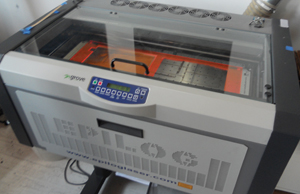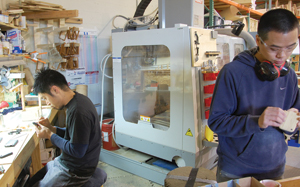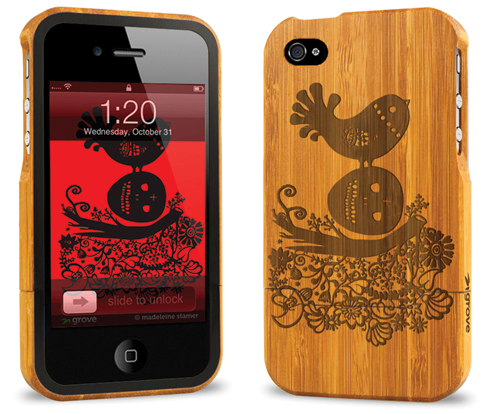
Wood cases for electronics have seen growing demand, with 150 offerings turning up at Etsy.com in species including maple, wenge, oak, walnut and sapele. Online retailer Srinc offers handcrafted inlaid cases in eucalyptus with hickory, zebra wood with walnut, and anigre with mahogany. At eBay dozens of wood phone cases are on sale — though woodgrain plastic is also common — including bamboo and redwood.
Wood case quality is defined by the precision of the crafting, says Grove’s Ken Tomita. His Portland, OR, firm has been churning out iPhone and iPad cases by the dozens, including custom designed versions created from client art. Limited run cases by select artists whose work is curated by Tomita are also big sellers.
While the launch of a new iPhone starts consumers queuing up days in advance at Apple stores, Grove begins tooling work weeks ahead of time, following the online rumor mill as it adapts the cases to what is projected to arrive on store shelves. The iPhone 5, expected in September or October, is generating even more buzz than usual with the announcement of Steve Jobs’ retirement.
 A new iPhone model means brand new designs for the wood cases that surround it, as camera lenses, speaker locations, and ports for chargers and ear buds move with each new design. Likewise for the iPad and subsequent iPad 2.
A new iPhone model means brand new designs for the wood cases that surround it, as camera lenses, speaker locations, and ports for chargers and ear buds move with each new design. Likewise for the iPad and subsequent iPad 2.
Tomita’s firm rode a dramatic growth curve with the iPad2, in part because of the exacting detail and refined design of the cases. “We spent a year on R&D,” Tomita says. “Then last spring, we launched the first product — the iPhone 3.” When the latest iPhone arrived, “that’s when our business really took off.” Employment grew from two in January to 18 by late summer. In April Grove began taking orders for iPad 2 cases; on May 10 of this year, the first run shipped.
“Joe and I kept tinkering with iPad concepts for a year,” Tomita says, noting online complaints about some designs by other makers that allowed the iPads to fall out of the cases.
Tomita makes masterful use of online marketing. Grove LLC’s website features a fully enabled e-commerce store, that allows customers to upload original art for one-of-a-kind iPad skins and jackets. Customers can also choose from original designs selected by Tomita and his staff, sometimes offered in limited runs.
 Tomita, who formerly operated a custom cabinetry and furniture design company, established Grove to develop precision-fit wood cases for iPhone 3s and skins, cases and covers for iPads. His goal: create high-style, high-tech wood products with the precision fit that attracts consumers to Apple’s cool design.
Tomita, who formerly operated a custom cabinetry and furniture design company, established Grove to develop precision-fit wood cases for iPhone 3s and skins, cases and covers for iPads. His goal: create high-style, high-tech wood products with the precision fit that attracts consumers to Apple’s cool design.
Tomita launched his firm late last year with his brother, Joe, after two years of development — much of it centered on software to drive Haas CNCs and a laser cutter from Epilog. The Hass CNC machining centers have been adapted for cutting wood; but they have no dust collection system. Tomita takes great pride in Grove’s ability to machine the wood to fit the sleek contours of the Apple electronic gadgets.
“We have an interesting mix of technology and hand work,” Tomita says.Tomita believes in doing everything internally, and “being happy internally. That leads to better work.” His management style is hands off, and “design is by the workers, and we continuously improve.”
A recently introduced black bezel on the iPhone 4 was developed with such input. The black trim on the case sets off the iPhone’s glass face. The two-piece iPhone cases are so precisely made that they slide together along the nearly invisible seam joining the front and back of the phone.
 Instead of creating designs in AutoCAD or some other 3-D design application, “We draw in the MasterCam application,” explains Tomita. A computer screen of a project in progress shows no color 3-D image, but line after line of raw MasterCam X5 computer code. “We design in it. We cut samples; then we tweak the program in MasterCam.”
Instead of creating designs in AutoCAD or some other 3-D design application, “We draw in the MasterCam application,” explains Tomita. A computer screen of a project in progress shows no color 3-D image, but line after line of raw MasterCam X5 computer code. “We design in it. We cut samples; then we tweak the program in MasterCam.”
Though maple has been used for some projects, and Grove has even cut cases from recycled skateboards, its specialty is working in bamboo.
“A real limitation is the material,” says Tomita. “A lot of time and energy goes into how to mill it.” Tomita says the crew at Grove has spent “hundreds of hours figuring out how to get it to cut cleaner. We have become experts in this raw material.”
Bamboo arrives in 4 x 8-foot sheets from Teragren or Bamboo Revolution, and is sized on a Powermatic saw, and is sanded in a General belt sander. After nested cuts on the CNC, cases are hand-sanded and left in either natural or a hand-oiled finish. Parts to be glued are held with custom-built jigs.
Growth has been accompanied by
challenges. For one thing, it is hard to keep up with demand. “We are always behind,” Tomita says. One-third of the staff are devoted to marketing and fulfillment; two-thirds to manufacture. “We are looking at how to scale up,” says Tomita. But he is intent on producing everything on site, to maintain quality. “If you want it done right, you do it yourself,” he says.
Another challenge is the space. Laser imaging devices must be vented to the outside, so the laser imaging area is on the top floor of a five-story factory. The CNC machines, adapted from metal working, are too heavy for the upper floors, and so are on a ground level workshop, requiring movement of materials between floors.
For some customers, wood cases serve as an antidote to the almost antiseptic quality of Apple’s minimalist design. For others, they provide a psychological buffer against damage and scratches.
“Apple products are so clean and shiny, with perfect looking materials,” says Tomita. “Pretty much when you take them out of the box for the first time they get damaged.” Wood cases, naturally imperfect, gain a patina that improves with age, which is part of their appeal, Tomita says.
“Our products are designed to wear; it’s the total opposite of Apple products.”
The finish is laid down with a four-step, proprietary process, using multiple oils: tung, aged linseed, sunflower, soybean, and thistle; plus beeswax, pure citrus solvent, pine rosin, and carnauba and candellila wax.
“From my many years of building custom furniture, I have always preferred a hand-rubbed finish.” Another secret to the process: Ken’s mother does much of the hand rubbed finishing at home.






Have something to say? Share your thoughts with us in the comments below.